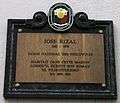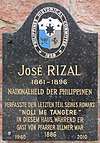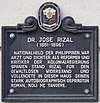List of historical markers of the Philippines overseas
This list of historical markers installed by the National Historical Commission of the Philippines (NHCP) outside the Philippines is an annotated list of people, places, or events in the region that have been commemorated by cast-iron plaques issued by the said commission. The plaques themselves are permanent signs installed in publicly visible locations on buildings, monuments, or in special locations. Many markers outside the country have been written in the local languages such as French, German, and Spanish.
The Kudan, the Philippine embassy building in Tokyo, has been declared a national historical landmark by the NHCP and was granted a historical marker on March 3, 2014. It is the first and currently the only overseas site to be granted such status.[1] During the unveiling of the marker, Ambassador Manuel Lopez called the building as the crown jewel of Philippine foreign service.[2]
Overseas markers
| Marker title | English Translation | Category | Type | Description | Location | Language | Date Issued | Image |
|---|---|---|---|---|---|---|---|---|
| Apolinario Mabini (1854–1903) |
Structure | Banished to Guam from 1901 with other Filipino political prisoners who are against the American rule. | Asan Point, Guam, United States | English | 1964 | |||
| Apolinario Mabini (1854–1903) |
Banished to Guam from 1901 with other Filipino political prisoners who are against the American rule. | Guam, United States | English | |||||
| The Arrival of Filipino Plantation Workers in Hawaii | They arrived on December 20, 1906. They were fifteen who came from Ilocos and the pioneer Filipino migrants in Hawaii. | Filipino Community Center, Waipahu, Hawaii, USA | English | September 16, 2006 | ||||
| Dr. Jose Rizal | Where Rizal lived in Berlin and wrote the latter half of Noli Me Tángere. | Berlin, Germany | English | |||||
| Dr. Jose Rizal | Where Rizal studied the local educational system and where he got famous for being an oculist. | Hong Kong | English | |||||
| Dr. Jose Rizal | Where Rizal began his annotation of Antonio de Morga's Sucesos de las Islas Filipinas. | London, United Kingdom | English | |||||
| Dr. Jose Rizal | Madrid, Spain | Spanish | ||||||
| Dr. Jose Rizal | Where Rizal lived in Paris and wrote the first chapter of Noli Me Tángere. | Paris, France | English | |||||
| Dr. Jose Rizal (1861–1896) | National hero of the Philippines, visited Chicago on May 11, 1888. | Filipino American Council of Chicago, Chicago, USA | English | 1993 | ||||
| Dr. Jose Rizal (1861–1896)[3] | National hero of the Philippines, where Rizal stayed in Vienna. | Leopold Hof Building, Vienna, Austria | German | June 19, 1995 |  | |||
| Dr. Jose Rizal (1861–1896)[4] | National hero of the Philippines, where Rizal stayed in Berlin. He was helped by Blumentritt on his campaign against the Spanish colonial regime. | Haus Jägerstraße 71, Mitte, Berlin, Germany | German | 2003 |
| |||
| Embahada ng Pilipinas Fujimi, Chiyoda-Ku, Tokyo |
Embassy of the Philippines Fujimi, Chiyoda-Ku, Tokyo |
Declared as a national historical landmark by the NHCP. | Chiyoda-ku, Tōkyō, Japan | Filipino,
A Japanese translation is provided under |
March 3, 2014 | .jpg) | ||
| Embassy of the Philippines Tokyo |
Building/Structure | Foreign Embassy | Building purchased by Jose P. Laurel for the Philippines. | Chiyoda-ku, Tōkyō, Japan | English | |||
| Jose Protacio Rizal
(1861-1896) |
National Hero of the Philippines. Martyred on December 30, 1896. | Newark Ave., Jersey City, New Jersey[5] | English | October 24, 2000 | ||||
| Jose Rizal | National Hero of the Philippines. House where he wrote El Filibusterismo. | 42 Rue Philippe de Champagne, Brussels, Belgium | French | 2007 |  | |||
| Jose Rizal | National hero of the Philippines. | Rosemeadow, Campbelltown, New South Wales, Australia | English | October 26, 2012 | ||||
| Jose Rizal (1861–1896) | National hero of the Philippines. | Carson International Sculpture Garden, 801 E. Carson Street, Carson, California, USA[6] | English | September 29, 2012 | _historical_marker.jpg) | |||
| José Rizal 1861–1896[7] | National hero of the Philippines, marking the house where Rizal wrote the final parts of Noli Me Tángere. | Wilhelmsfeld, Germany | German | January 4, 1960 |  | |||
| José Rizal 1861–1896[8] | National hero of the Philippines, ophthalmology clinic of Rizal in Paris . | Paris, France | French | 1959 | ||||
| José Rizal 1861–1896 | National hero of the Philippines, where Rizal lived when he published the Fili. | Henegouwenstraat 9, Ghent, Belgium | French | 1959 |
| |||
| Paduka Batara | King of Sulu who died in Dezhou. He travelled to China in 1417 to pay tribute to Emperor Yongle. | Dezhou, China | English | May 23, 1999 | ||||
| The Philippine National Flag | Where the first flag was sewn by Marcela Mariño Agoncillo and her companions Lorenza Agoncillo and Delfina Herbosa Natividad. First hoisted during the Battle of Alapan. | Morrison Hill, Hongkong, China |
See also
References
Footnotes
- ↑ "Envoy's residence in Japan becomes PHL's 1st overseas historical landmark". GMA News Online. Retrieved 2018-01-29.
- ↑ "Philippine Ambassador's Official Residence in Tokyo Proclaimed Philippine "National Historical Landmark" | Philippine Embassy – Tokyo, Japan". tokyo.philembassy.net. Retrieved 2018-01-29.
- ↑ http://knightsofrizal.org/?p=268 Did he or didn't he?
- ↑ http://cbrainard.blogspot.jp/2014/10/travel-berlin-germany-update-1.html Travel: Berlin, Germany- Cecilia's Update #1
- ↑ "PHOTOS: 150th birthday of Philippine National Hero Jose Rizal celebrated in Jersey City". NJ.com. Retrieved 2018-02-13.
- ↑ "Unveiling for First Monument on Carson's International Sculpture Garden Scheduled for Sept. 29". BakitWhy. September 5, 2012. Retrieved April 20, 2018.
- ↑ http://ufreytag.michel-media.de/page13.html The Wilhelmsfeld Story of José Rizal
- ↑ http://xiaochua.net/2013/07/24/xiao-time-18-july-2013-fall-of-the-bastille-ang-pransiya-at-ang-pilipinas/ XIAO TIME, 18 July 2013: FALL OF THE BASTILLE: ANG PRANSIYA AT ANG PILIPINAS
Bibliography
- National Historical Institute (2008). Historical Markers (1992–2006). National Historical Institute.
- A list of sites and structures with historical markers, as of 16 January 2012
- A list of institutions with historical markers, as of 16 January 2012
External links
| Wikimedia Commons has media related to Historical markers in the Philippines. |

